Welcome to Maryland, the state where waterways weave a compelling tale of life, both above and beneath their shimmering surfaces. From the Potomac’s broad expanse to the Choptank’s winding course, these rivers hold secrets that often surprise their visitors. The secret we’re unraveling today? Snakes.
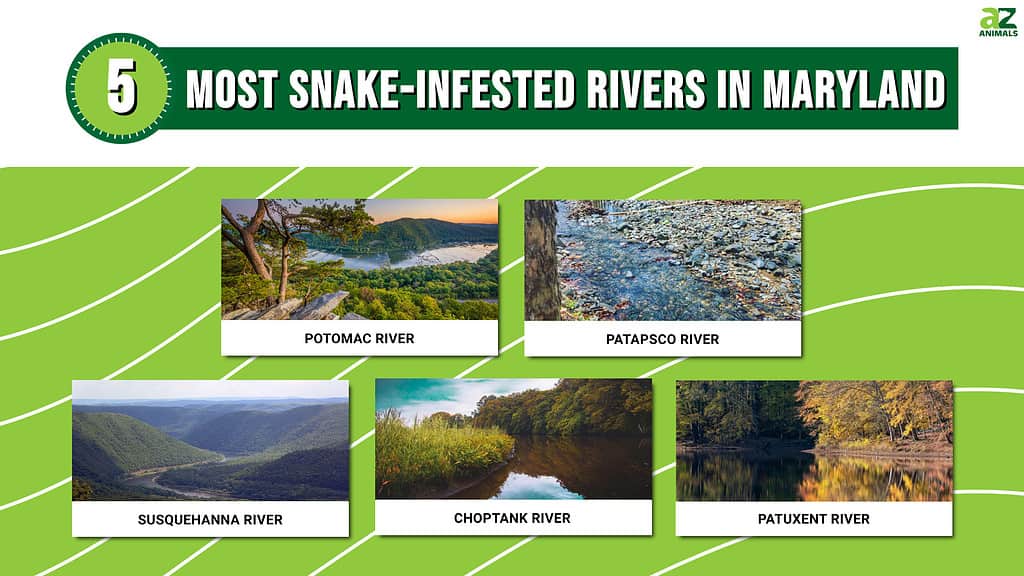
Our journey takes us through five iconic Maryland rivers: the Potomac, the Patapsco, the Susquehanna, the Choptank, and the Patuxent. Each waterway is a thriving abode for a diverse range of snake species, from the common and harmless eastern garter snake to the elusive and venomous eastern copperhead.
Pack your sense of adventure as we’re about to traverse these riverine habitats. We’ll delve into the snake species found in each river, discuss their unique behaviors, recount documented encounters, and share some safety tips. Remember, we’re visiting their homes, so let’s tread lightly and respect their spaces.
Ready for a dive into the world of Maryland’s snake-infested rivers? Let’s get started!
1. Potomac River

The Potomac runs over 383 miles from Fairfax Stone, WV, to Point Lookout, MD.
©iStock.com/Jon Bilous
Gazing at the impressive expanse of the Potomac River, it’s easy to see why it’s more than just a river. It’s a cradle of life, bustling with diverse ecosystems, one of which is its intriguing snake population. Let’s delve deeper into the serpentine inhabitants of this beautiful river.
Unfolding the Charm of Potomac
The Potomac River, with its sprawling 383 miles, is an ecological marvel, an intricate network of habitats that houses a wide range of life forms. This isn’t your average river. It morphs as it flows from deep valleys to marshy swamps, each transition bringing with it a rich tapestry of life. As it cuts through the varied landscapes, it accommodates numerous snake species, each making its home in a different segment of the river.
The Serpentine Tapestry: Species and Estimated Numbers

Eastern rat snakes are just one of a few snakes you may see on the Potomac River.
©samray/Shutterstock.com
Snakes of the Potomac — what’s the count? Well, it’s not just about the numbers but the variety. The eastern garter snake, one of the most common and harmless snakes in this Maryland area, is seen frequently slithering in grassy habitats near the river. The northern copperhead, a venomous species, is less common but still present, favoring rocky areas and woodlands. The eastern rat snake, often reaching up to seven feet, is an impressive sight, while the northern water snake is a proficient swimmer, often seen darting through the water or basking on the river banks.
Distinctive Aspects of the Snake Population
Every snake species on the Potomac River has its unique traits and behaviors. Northern water snakes are true sun-worshippers, often found sprawled on rocks soaking in the sunshine. Their keen hunting skills are often on display as they ambush their prey in the water. Meanwhile, the eastern rat snakes are proficient climbers, often found high up in trees or on rocky ledges. Their excellent climbing skills often lead to surprises for the less observant visitors.
Documented Encounters
Snake encounters on the Potomac, fortunately, aren’t straight out of a horror movie. Many are peaceful, even awe-inspiring. Numerous reports highlight instances of snakes basking on rocks, occasionally swimming across the river, or even peeking out from tree branches. There are accounts of surprise encounters too. Imagine taking a break from kayaking, only to find a northern water snake hitching a ride on your kayak!
Safety Precautions for Visitors
Now, all this talk about snakes shouldn’t scare you off. It’s their home, after all. But, a few precautions can go a long way. When near the river, be observant. Check where you sit or step. Never attempt to pick up or handle a snake in this Maryland river; they’re not toys and can react when threatened. If you spot a snake, enjoy the moment, maintain a safe distance, and let it go about its business.
2. Patapsco River
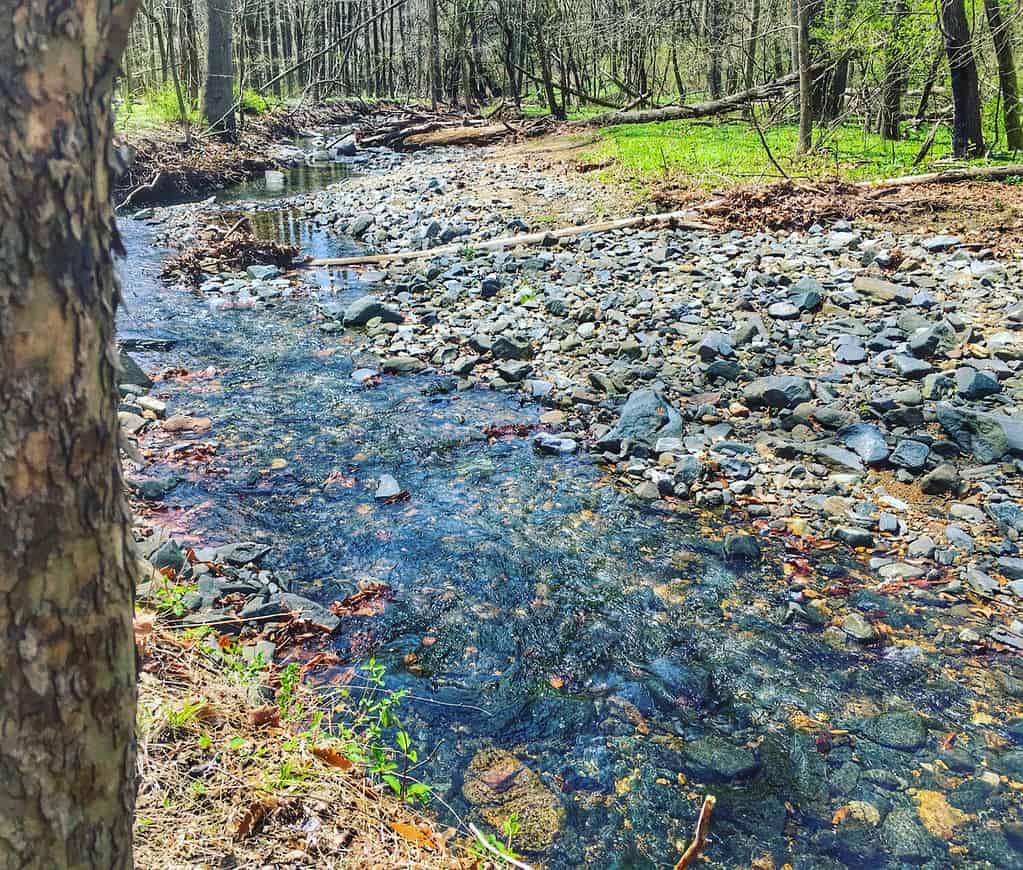
Patapsco Valley State Park in Catonsville, MD, is where visitors can find the Patapsco River.
©John Pink/Shutterstock.com
Take a trip along the vibrant Patapsco River, and you’ll quickly realize it’s more than just a waterway. It’s a bustling habitat, a haven for countless species, snakes included. Let’s traverse its winding path and delve into the life of its resident serpents.
The Allure of Patapsco
The Patapsco River, winding through 39 enticing miles, is a living, breathing display of ecological diversity. This river alters its personality as it meanders, with serene forests, rocky outcrops, and calm pools, each serving as home to a myriad of species. It’s a paradise for snake species that thrive in the diverse habitats offered by this dynamic Maryland river.
Snake Species and Their Estimated Numbers

Northern copperhead snakes are one of North America’s most common species of venomous snakes.
©JacobLoyacano/Shutterstock.com
Patapsco’s serpent residents aren’t shy. From the abundant eastern garter snakes to the elusive northern copperheads, this river is a refuge for an array of snake species. The eastern hognose snake, known for its theatrical “playing dead” routine, also calls Patapsco home. Of course, the ever-adaptable northern water snake is part of the lineup, relishing the river’s aquatic bounty.
Unique Aspects of Snake Population
Every snake along the Patapsco River has its own quirks and characteristics. Northern water snakes, for example, are quite the opportunists. When it’s feeding time, you’ll often see them darting through the water with agility, ambushing their prey. Eastern hognose snakes, on the other hand, have mastered the art of deception. If threatened, they perform a convincing act of “playing dead,” complete with a belly-up display!
Documented Encounters
Think all snake encounters along the Patapsco are hair-raising? Think again. Many are simply instances of peaceful cohabitation. Some folks have seen northern water snakes sunning themselves on river rocks in Maryland. Others have been treated to the eastern hognose snake’s dramatic performances. Yes, there have been a few unexpected surprises, too — like spotting a snake during a picnic!
Safety Precautions for Visitors
While the serpentine residents of Patapsco are fascinating, safety should always be a priority. Be alert near the river, especially in rocky and grassy areas. If you stumble upon a snake, resist the urge to touch or pick it up. Instead, enjoy watching it from a distance. It’s their home, after all.
3. Susquehanna River
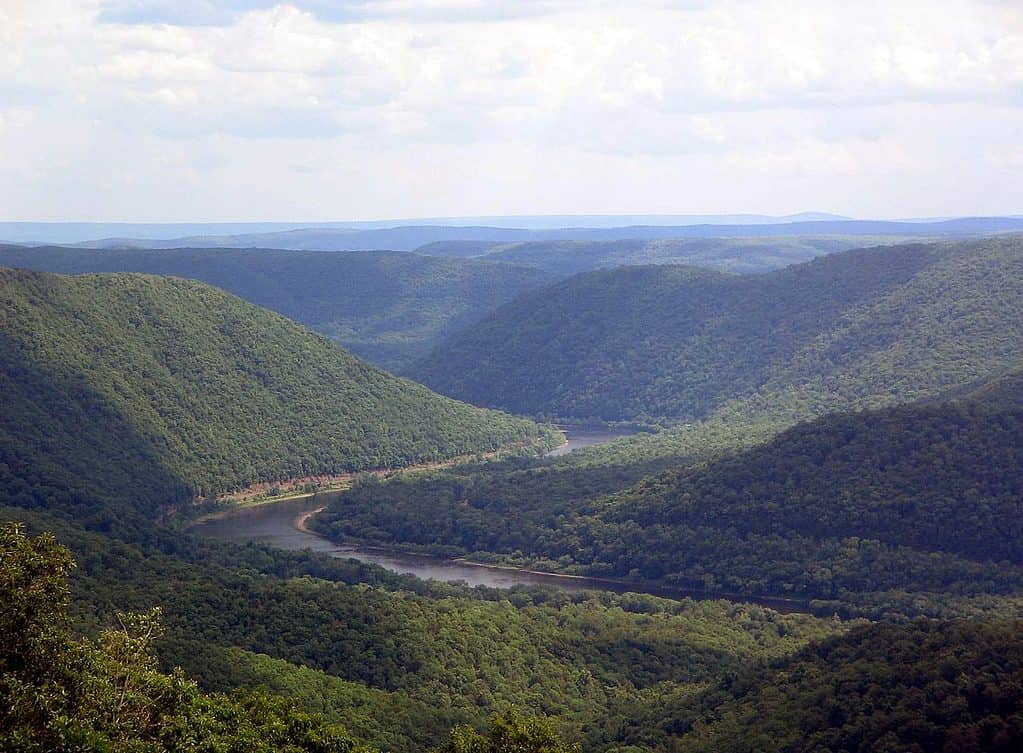
At 444 miles (715 km), the Susquehanna River is the longest river on the East Coast of the USA.
©Ruhrfisch / CC BY-SA 3.0, via Wikimedia Commons – Original / License
Welcome to the Susquehanna River, a vast waterway teeming with life, and yes, that includes snakes. It’s time to peel back the surface of this 444-mile marvel and explore the world of the slithering inhabitants who call it home.
The Splendor of Susquehanna
The Susquehanna River, in its massive span, presents an ecosystem as expansive as it is diverse. As it stretches and twists, it carves out a host of habitats, from dense forests to sun-dappled marshes. With such a variety, it’s no wonder the Susquehanna is a magnet for a broad range of snake species.
Snake Species and Their Estimated Numbers
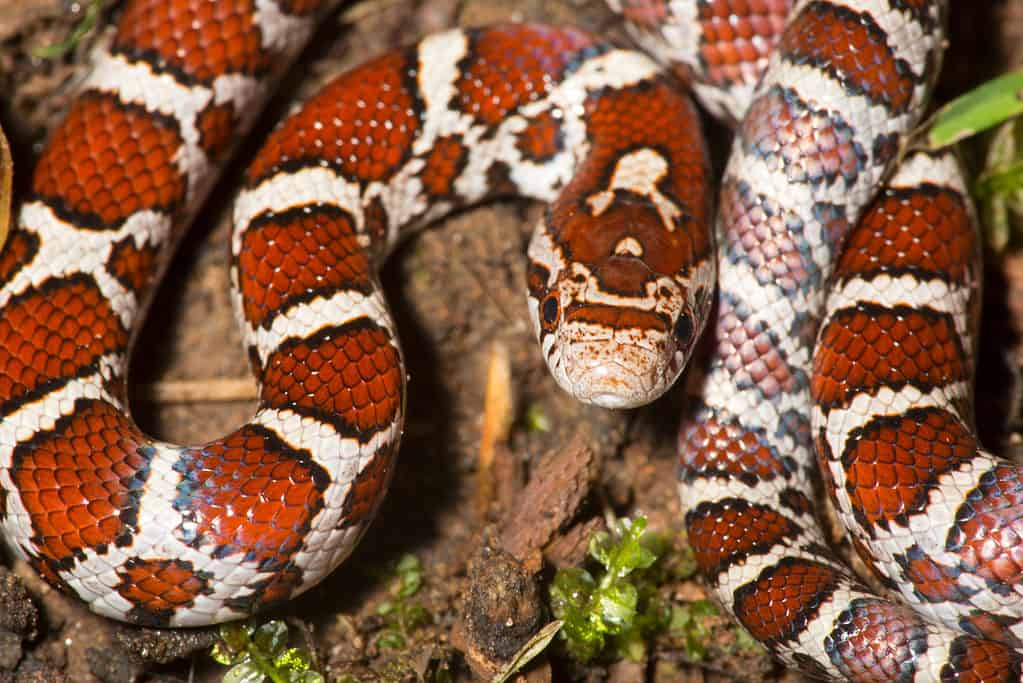
Closeup of a young eastern milk snake partly coiled up in a garden.
©Jeff Holcombe/Shutterstock.com
Along the Susquehanna River in Maryland, the snake population is as diverse as the habitats. The harmless yet strikingly patterned eastern milk snake is a frequent sight here. The venomous timber rattlesnake, while not common, is another resident of the area, favoring the rocky landscapes. Then, there’s the northern water snake, a master of aquatic ambush, making full use of the river’s resources.
Unique Aspects of Snake Population
Snakes along the Susquehanna each have their unique lifestyles and behaviors. The eastern milk snake, for example, is often found in forested areas, hunting for rodents and other small prey. Timber rattlesnakes are known for their sedentary behavior, often basking on sunny rocks and waiting for prey to come within striking range. Northern water snakes exhibit excellent swimming skills, diving and writhing through the water in search of a meal.
Documented Encounters
Visitors to the Susquehanna may be surprised to learn that snake encounters here are often peaceful. Some report seeing northern water snakes swimming along the river, while others have stumbled upon eastern milk snakes hunting in the grasslands. And yes, there have been the occasional surprises, too — like finding a timber rattlesnake sunning on a hiking trail!
Safety Precautions for Visitors
As intriguing as the snakes of Susquehanna are, safety must always come first. Be aware of your surroundings, especially near rocky or grassy areas. If you spot a snake, resist the urge to get too close or touch it. Instead, admire it from a distance and remember this is their territory.
4. Choptank River
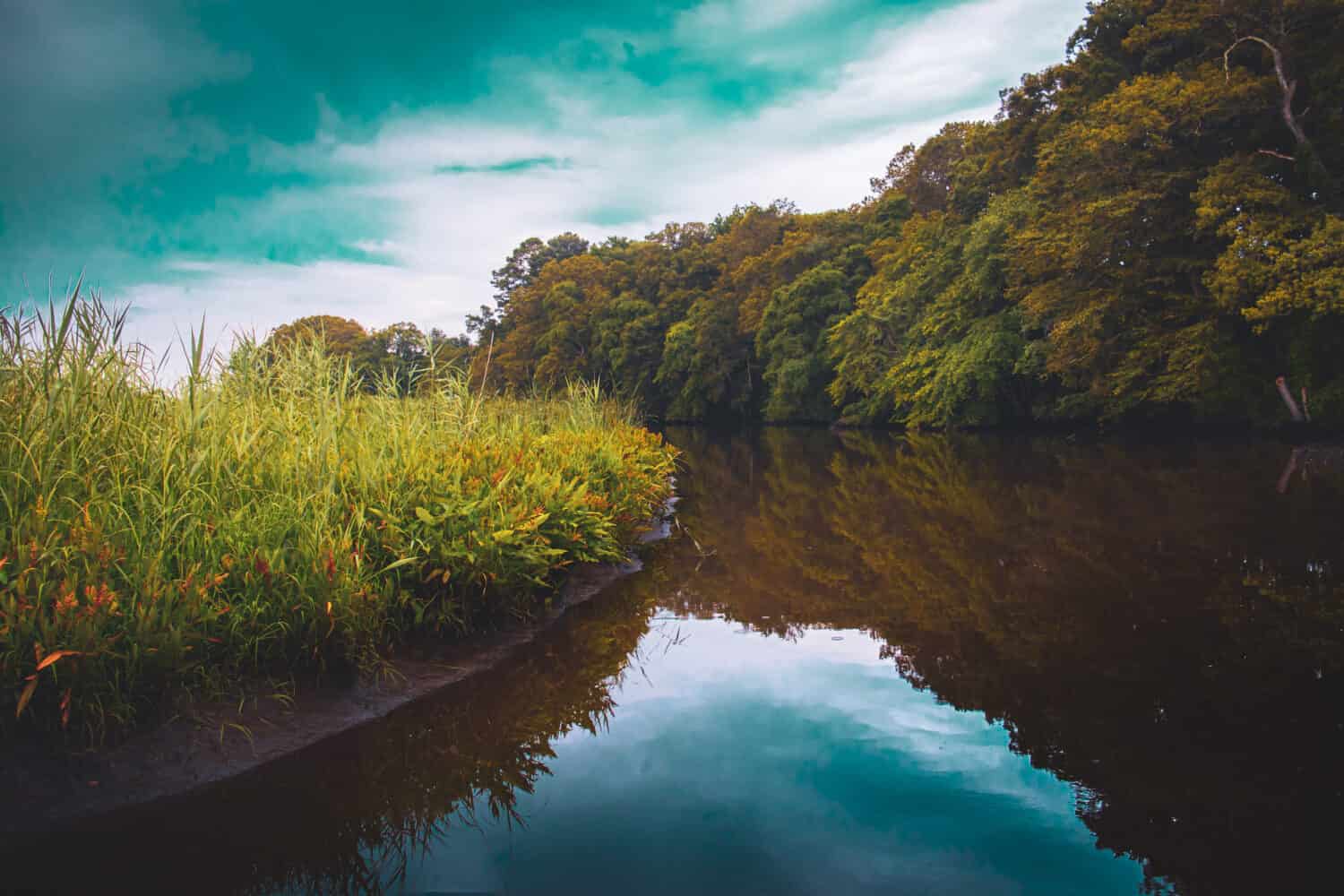
Beautiful marsh grass grows at the edges of the Choptank River in Preston, MD.
©Chris Guy Jr/Shutterstock.com
Prepare to journey along the Choptank River, a fascinating tapestry of life, where the weaving of water and land creates a haven for an array of species, including snakes. Let’s navigate its 71-mile course to uncover the secrets of its serpentine residents.
The Majesty of Choptank
The Choptank River is a testament to the sheer beauty of ecological diversity. With its shifting scenery of tranquil forests, rocky banks, and marshy wetlands, it provides a mosaic of habitats for numerous snake species. It’s no surprise that the Choptank teems with slithering life.
Snake Species and Their Estimated Numbers
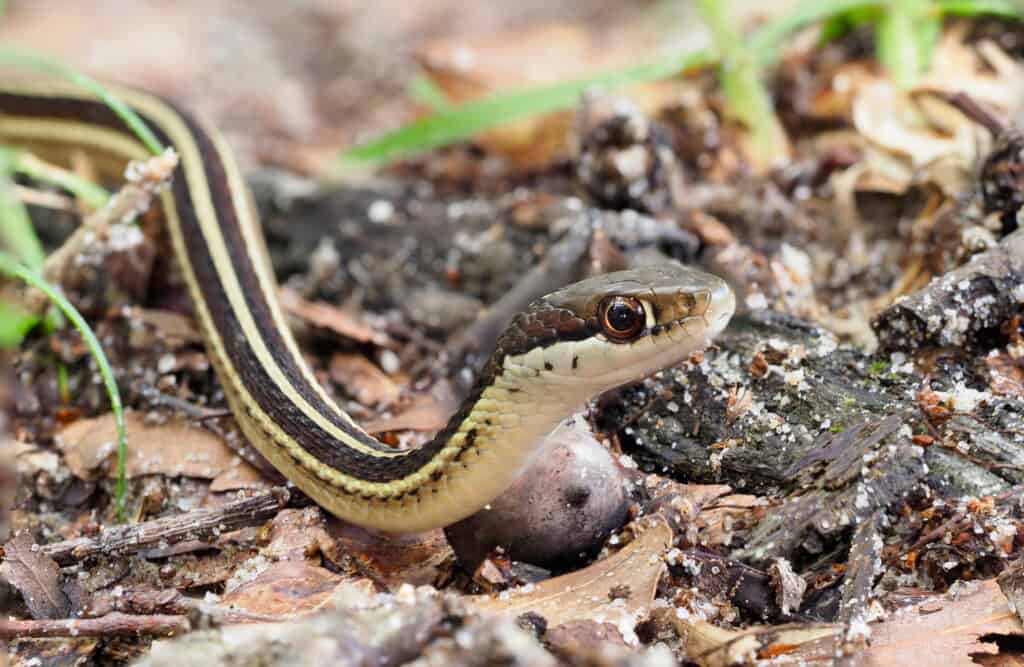
The eastern ribbon snake will exude a foul-smelling musk odor from its body if handled.
©Steve Bower/Shutterstock.com
The variety of snake species along the Choptank River in Maryland is a testament to the river’s diversity. From the agile eastern ribbon snake, which frequently visits the water’s edge, to the smooth earth snake, a small but present species, the Choptank River is a sanctuary for snakes. Of course, we can’t forget the ubiquitous northern water snake, which is always ready to take a dip.
Unique Aspects of Snake Population
The snakes along the Choptank River each boast their unique traits and characteristics. The eastern ribbon snakes, with their slender bodies, are agile swimmers and can be seen darting in and out of the water in pursuit of prey. As for northern water snakes, their robust bodies enable them to navigate the river’s currents with ease.
Documented Encounters
Snake encounters along the Choptank are often more peaceful than petrifying. Many visitors have reported seeing northern water snakes lazing on riverbanks, while others have encountered the slimmer eastern ribbon snakes zipping through the water.
Safety Precautions for Visitors
While the snakes of the Choptank River are indeed fascinating, it’s crucial to prioritize safety. Stay aware of your surroundings, especially near water, grassy, and rocky areas. If you come across a snake, remember to admire it from a safe distance and avoid any attempt to touch or handle it. This is their home, after all.
5. Patuxent River

The autumn foliage that grows along the Patuxent River in Maryland has gorgeous colors.
©Robert A. Powell/Shutterstock.com
Embark on a journey along the Patuxent River, a vital 115-mile waterway where the diversity of life is as broad as the river itself, snakes included. Let’s traverse its diverse landscapes and uncover the fascinating world of its slithering residents.
The Wonders of Patuxent
The Patuxent River is a marvel of natural diversity, with its sweeping landscapes ranging from shady forests to rocky terrains and marshy swamps. These ever-changing environments form a mosaic of habitats, each providing a unique home for a range of snake species that call the Patuxent River their home.
Snake Species and Their Estimated Numbers
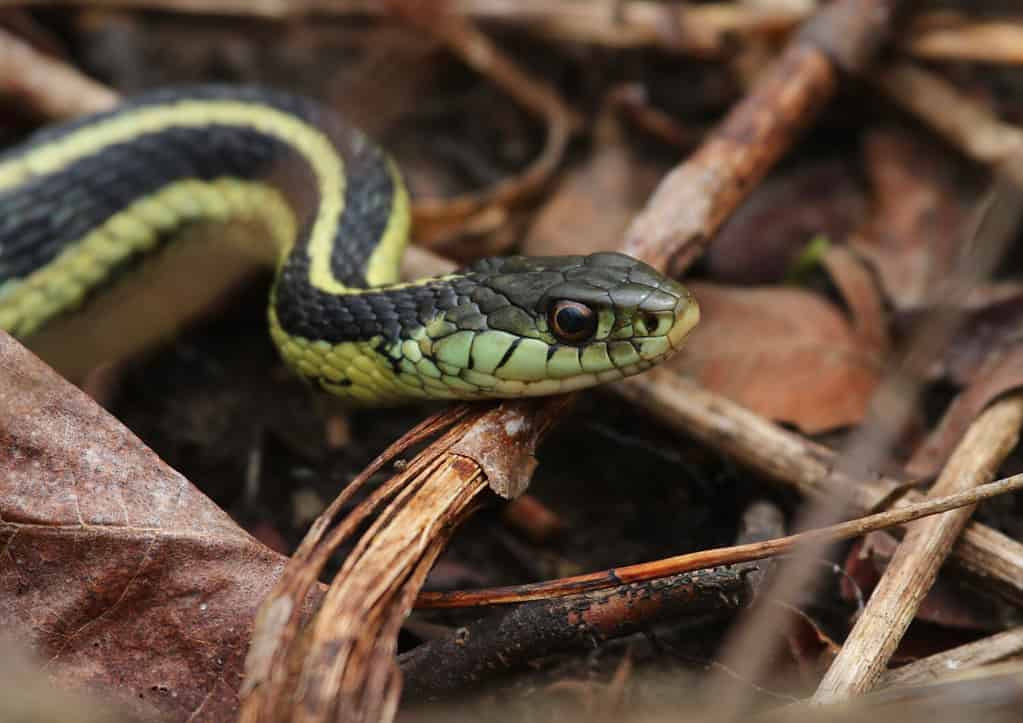
Adult eastern garter snakes grow to 18 to 26 inches long with keeled (ridged) scales and variations in their coloration and patterns.
©Chris Hill/Shutterstock.com
The variety of snake species found along the Patuxent River in Maryland speaks volumes about its ecological diversity. From the small and harmless eastern garter snake to the sleek and venomous eastern copperhead, the Patuxent is a refuge for these and many other snake species. The agile northern water snake, comfortable in both water and on land, also enjoys the river’s abundant resources.
Unique Aspects of Snake Population
Each snake species residing along the Patuxent River brings its unique set of traits and behaviors. Eastern copperheads, for example, freeze instead of moving away from threats. The eastern garter snakes, on the other hand, are adaptable and can be seen in various environments near the river. Northern water snakes are agile swimmers and often surprise onlookers with their hunting prowess in the river.
Documented Encounters
Snake encounters along the Patuxent are often less frightening than one might imagine. Many visitors have reported sightings of northern water snakes basking in the sun on the riverbanks. Others have encountered eastern garter snakes nestled in grassy areas. And, of course, there have been the occasional surprising encounters — such as stumbling upon an eastern copperhead during a forest hike!
Safety Precautions for Visitors
Despite the captivating nature of the Patuxent River’s snakes, it’s essential to maintain safety during your exploration. Remain vigilant, especially in grassy and rocky areas near the river. If you encounter a snake, remember to keep a safe distance and resist the urge to touch or handle it. This, after all, is their natural habitat.
Key Takeaways
And that’s a wrap on our riverine adventure through Maryland! From the mighty Potomac to the serene Patuxent, we’ve traversed the state’s iconic waterways, unveiling their slithering secrets. We’ve met an array of snake species, each bringing its own dash of drama and uniqueness to the river they call home.
This journey has shown us that these rivers aren’t just bodies of water; they’re lifelines for countless species, including our scaly friends. We’ve witnessed the agility of the northern water snake, admired the deceptive antics of the eastern hognose snake, and respected the master camouflage of the eastern copperhead.
As we wrap up, let’s remember the golden rule of visiting these rivers: respect. If we stumble upon a snake, let’s keep our distance and admire these intriguing creatures from afar. After all, we’re just guests in their riverside homes.
Whether you’re a wildlife enthusiast, an angler, or someone who simply appreciates nature, remember that each visit to these rivers brings a potential snake encounter — an exciting snippet of the wild right in our own backyard.
The photo featured at the top of this post is © ladyphoto89/Shutterstock.com
Discover the "Monster" Snake 5X Bigger than an Anaconda
Every day A-Z Animals sends out some of the most incredible facts in the world from our free newsletter. Want to discover the 10 most beautiful snakes in the world, a "snake island" where you're never more than 3 feet from danger, or a "monster" snake 5X larger than an anaconda? Then sign up right now and you'll start receiving our daily newsletter absolutely free.
Thank you for reading! Have some feedback for us? Contact the AZ Animals editorial team.







